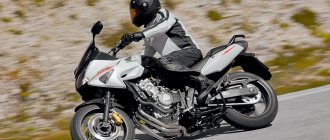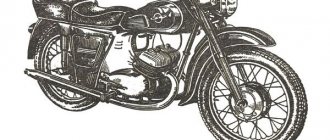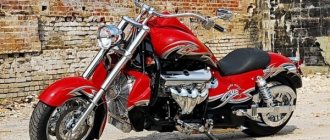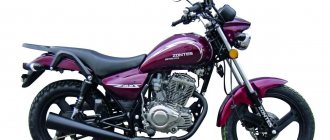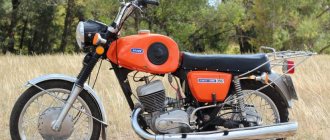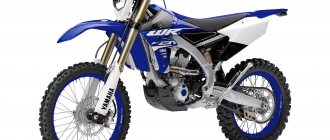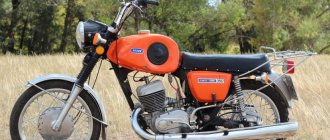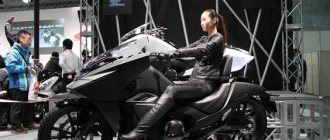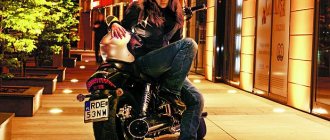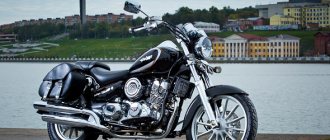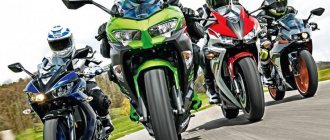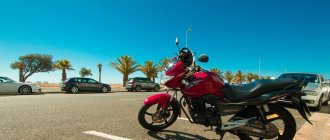Bold and aggressive, with a classic appearance, but a sporty character - this is how streetfighter motorcycles are created. These are a kind of superheroes who have descended from the pages of comic books onto the city streets. And such a comparison is not accidental - after all, back in the 80s of the last century, prototypes of “street fighters” were depicted in British comics. No fairings, passenger seat, windshield or other details that distract from fast driving - this is how street fighters were depicted in the pictures, and this is how they became in real life. The first representatives of the class began to appear when the owners of sport bikes took off their extra uniform and motorcycle protection with their own hands, and left the garage ready for exploits. This is where another name comes from – naked (naked from English “naked”).
Contemporary pop culture also fuels interest in “naked” bikes. So, Ryan Reynolds’ hero in the guise of Deadpool rides a heavily modified, but recognizable Suzuki SV1000. And Rockstar Games (the creators of the GTA game series) went even further and developed a hybrid of the Honda CB400N and Yamaha RZ250 for Vice City, and for the fifth online version they created the formidable Vortex, using the Ducati 1199 Panigale as a basis.
If your favorite heroes or the bikes rushing by inspired you to buy a streetfighter, it’s time to read our review and choose a motorcycle that you like. You can find current offers on street fighters at our online auction.
KTM Duke 690
Externally, the motorcycle is contrasting and daring. Chopped lines give balance and integrity. The main advantage is the fit. The short tank does not force you to reach far towards the steering wheel - the landing is almost vertical and with a straight back. The single-cylinder engine makes this bike narrow, so your knees hug the tank comfortably.
Lightweight technology is important in the city, the Duke weighs 160 kg with a full tank, which is not even enough for a road motorcycle. An adult motorcycle in terms of cubic capacity is more reminiscent of a 125 or 200 cc, and all thanks to the constructors and designers who made it compact.
The comfortable speed of this motorcycle is 125-135 km/h. It is in this high-speed mode that the back and arms do not get tired. The ABS system allows the rider not to think about the force of pressing the brake handle and pedal. The fork diameter has decreased to 43mm, but now there is no hydraulic adjustment, and the shock absorber is also not hydraulically adjustable.
The steering angle has increased, which gives the motorcycle confident maneuverability.
This bike is popular only in the metropolis; it is in very dense traffic that the full potential of the motorcycle is revealed. Residents of other cities will not understand a motorcycle without plastic that does not go 250.
Kawasaki Ninja 500 2007
Despite the fact that production of the model was discontinued back in 2009, this sport tourist is significantly unified with the more popular models: KLE500, ER 5 and EN500 (Vulcan), so it is not difficult to find spare parts for it. The remarkable thing about this “Cava” is that the motorcycle is very narrow, maneuverable, light, like a YBR, durable, like a 750, and absorbs less fuel than 400 cc models. A small “minus” is the rather archaic appearance of the fairing, but a huge “plus” is that it copes with its duties perfectly. Part of the body kit, like the trunk, by the way, can be supplied from larger models. You can easily travel with two people on this Ninja, plus load 50 kilograms of luggage - 60 “horses” accelerate it to a cruising speed of 120–130 km/h. If you want to go it alone, downhill, with a tailwind, you can drive 200 km/h.
If you have a little maintenance skills, you can operate this copy, which has not yet completed 50 thousand, without problems for several more years.
Honda CB600FA
One of the most significant models in Europe among middle-weight motorcycles in the “Naked” class is the Honda CB600F Hornet.
Confident power, comfort, lightness and ease of use make this motorcycle ideal for the city. The modern and stylish design has won the hearts of motorcyclists.
Based on consumer preferences, the appearance of the motorcycle was also developed. By combining the improved design of the instrument panel with the headlight, it was possible to give a more streamlined shape to the front of the motorcycle. And the panel itself with a digital LCD tachometer, speedometer, dual trip meter, fuel gauge and clock not only complements the innovative style of the motorcycle, but also makes driving the machine much easier. The CB600F Hornet features a compact engine with an innovative PGM-FI electronic fuel injection system, a combined version of the advanced ABS anti-lock braking system and a large number of advanced high-tech equipment to ensure optimal levels of safety and comfort. Thanks to the modifications carried out, the CB600F Hornet can rightfully be considered a leader in the “Performance Naked” class of motorcycles with a medium engine capacity.
Good resource motorcycles costing less than RUR 150,000
This is my personal “rating”, not associated with any “top 10” (or top recommendations of trading platforms), in which popular “Japanese” are the leaders among the contenders. Seriously, if you need a good motorcycle from the “maximum rides – minimum money for repairs” category, choose one of the representatives of the “Big Four”: Yamaha, Honda, Suzuki, Kawasaki. They make it possible to implement the same principle: “to be, not to appear” - they are quite legendary, powerful enough, capable of giving several more years (even decades) of pleasant operation.
Yamaha MT07
The company claims that the motorcycle is suitable for advanced riders who have grown out of small-capacity equipment, but have not yet grown to the size of a liter.
The key secret to the unique character of the MT-07A is its engine. Featuring uneven firing intervals, the 270-degree crankshaft delivers powerful acceleration and excellent traction. Torque is linearly distributed over the entire operating range.
The design of the linkage rear suspension is made using the Monocross system. The monoshock is mounted horizontally directly on the engine crankcase. For a better feeling of acceleration, the MT-07A features a short 530mm rear suspension swingarm.
The motorcycle weighs 180 kg, which is undoubtedly a plus for the city.
Yamaha FZ6 2008
Not yet “sport”, no longer “classic”. The derated engine from the R6 ring, equipped with an injector, accelerates 187 kg of dry mass to 10 tons of revolutions very smoothly and predictably, so the “Phaser” can even be taken as a first serious motorcycle. This “six hundred” is a very good option for a metropolis like Moscow. Firstly, it makes it possible to seat a girlfriend (or friend) of almost any size as the “second number”, without losing dynamics and stability. In comparison, the “four hundred” cars “die” noticeably, and some of them strive to “become an asshole” if the passenger feels like stretching their legs or waving a hand at someone. Secondly, a naked is a naked: not an ounce of excess plastic, which tends to chip, causing unnecessary repair costs, a dense, balanced layout, a straight, comfortable fit, comfortable even for drivers above average height.
A remarkable option, slightly past the “psychological mark” of 50 thousand mileage, but quite vigorous and combative.
Kawasaki ER6-N
In motorcycle circles the motorcycle was called “Ruff”. The interesting anti-fashion design and attractive price are the points that attract Kawasaki lovers. Riders note the comfortable fit. Because of the wide steering wheel, you have to slow down in narrow aisles.
Among the technical features of the motorcycle:
- 8-valve EFI with Keihin throttle bodies and electronic ignition;
- Modern electric starter;
- Six-speed gearbox;
- Multi-disc clutch in oil bath.
The motorcycle is balanced in handling thanks to the stable suspension. At the front, all-new high-tech dual brakes with 300 mm discs and double piston were installed. Only small-capacity sportbikes can boast of such a system.
What types of motorcycles are there?
Two-wheeled vehicles are divided into the following types:
- Classic – characterized by simplicity of form and ease of maintenance; they can be of any cubic capacity. Suitable for everyday riding thanks to the flat riding position.
- Tourist - characterized by increased seat comfort, the presence of luggage compartments, as well as power and significant cubic capacity. They are used on asphalt roads, but for less than ideal roads, a subtype of touring bike - a tourer - is suitable.
- Sports - when designing them, the main emphasis is on obtaining maximum power and controllability. A sports bike designed for racing tracks and routes of increased difficulty. Most of them are not used in the city due to the lack of lighting elements.
- Cruisers - their feature is an elongated fork, which is why the driver’s seating position is quite specific - tilted back. Cruisers are good in the city, but due to their size, they are not suitable for beginners.
- Enduro are the best models for off-road and bad roads. Depending on the design features, they are divided into different types and some are prohibited for use in the city, for example, cross-country ones. The cross bike is designed for cross-country motorcycle racing. But an enduro motard, equipped with wheels and brakes of sports models, is good for driving around the city and does not require high qualifications from the pilot.
- Electric motorcycles are the body of a gasoline sports motorcycle combined with a Li-ion block battery.
- scooters are maneuverable, easy to operate, small in size and inexpensive transport for city trips.
Yamaha XJ6N
The Yamaha XJ6N is a versatile mid-sized bike tuned for leisurely riding. The motorcycle is intended primarily for novice riders: it is very easy to control. The engine begins to produce maximum thrust at very low speeds, so you can start almost from idle. This characteristic also contributes to vigorous starts from traffic lights: the XJ6N can “shoot” faster than many more powerful bikes.
At the same time, all controls are made as soft as possible to make it more comfortable for a novice rider. Due to the steel frame, the motorcycle turned out to be quite heavy. The suspension is simple in design. Its capabilities are enough for a comfortable ride on high-quality roads, but on uneven asphalt it will not be very comfortable. Naturally, it is better not to go on primer roads.
The bike looks aggressive due to the deliberately protruding headlights and the overall dynamism of the image. Overall, it is perceived as more expensive than it actually is. The simple and clear dashboard leaves a pleasant impression, and the rear-view mirrors do not vibrate in any of the driving modes. There are vibrations on the controls, but they are insignificant. But the seat is not very comfortable. It is set low, made too narrow and rigid. Because of this, there is no feeling of unity with the motorcycle, and it is not very pleasant to ride.
Motorcycle comparison:
| Volume | Weight | Max. speed | Price, rub) | |
| KTM Duke 690 | 690 cm3 | 160kg | 200km/h | 840 000 |
| Honda CB600FA | 599cm3 | 207kg | 221km/h | 429 900 |
| Yamaha MT07 | 689 cm3 | 180kg | 190km/h | 575 000 |
| Kawasaki ER6-N | 649 cm3 | 204 kg | 174 km/h | 458 300 |
| Yamaha XJ6N | 600 cm3 | 210kg | 220km/h | 564 900 |
Character traits
The main distinguishing features of streetfighter-style motorcycles are the combination of aggressive design with impressive technical characteristics. The raised tail, the brazenly protruding frame, the exposed engine, the almost complete absence of a plastic body kit - all this immediately reveals the character of the motorcycle. Customizers who want to build their own streetfighter often also get rid of the passenger seat, sacrificing practicality for style. Moreover, in some cases the tail lifts up so high that it would still be impossible to sit on it even if there was a second seat, since the passenger would have to practically lie on the pilot’s back. There is no wind protection at all , which makes driving at high speeds problematic, since the driver is simply blown away by the oncoming air flow. However, bikes of this type are usually designed for city riding and speeding through the streets at night, and not for long journeys. The donors for custom bikes are most often sportbikes, and less often – ordinary classic “road bikes”. A specific donor is usually selected based on the financial capabilities of the owner - for some, a 15-year-old Suzuki GSX is enough, and for others, they are able to buy themselves a brand new “liter”, choosing from many options. In the end, a motorcycle should bring pleasure to its owner, and everything else is secondary.
Suzuki Bandit GSF 1200 1998
And here – fans of Suza will greet me with incomprehension – why was the so popular “Bandit” sent almost to the “tail” of the list? I try to evaluate by many criteria, and the “friendliness” of a technology in relation to a beginner is not the least of them. Precisely because “two hundred liters” cannot be called user-friendly - it occupies an honorable, fourth place. The bike is very charismatic, “angry”, torquey, despite the significant derating of the engine (originally belonging to the sports “Jixer”), producing almost 100 “horses” and accelerating 211 kg of weight to 240 km/h. A passenger on a “beast” that reaches 100 km/h in almost 3 seconds must be ridden with caution. This “Bandit” is definitely not a humane choice as a first motorcycle, but it can give “wings” to an experienced rider in the traffic. If you find a version with the index S (sport-tourist) - in the next ten years you will be able to “wind up” another 30 “thousands”.
One of the very rare examples, falling into the price range due to the need for repairs.
Suzuki Bandit GSF 400
The younger “brother”, undeservedly left in the shadow of the liter “Bandit”, on the contrary, is a very good choice for a beginner. The classic, initially produced only for the domestic market, turned out to be so popular that it not only made its way to the West and East, but was produced for another 20 years almost unchanged, in parallel with improved models. The dynamic in-line 4-cylinder water-cooled carburetor engine produces a stable 59 hp. With. As in the case of the “SiBiha”, the bike is predictable (even sluggish) in the first gears and demonstrates an impressive “pickup” at speeds above 10 thousand. When equipped, the weight of the motorcycle exceeds 180 kg, but this does not affect handling and the bike steers well in the stream. Allows the carriage of a passenger, even without much loss of dynamics. Consumes a little more than 5 liters per hundred, accelerates to 170–180 km/h. A small “minus” is the lack of front suspension adjustments and very soft rear shock absorbers. Thanks to the ease of maintenance and the abundance of spare parts on the market (both new and contract), the model can live for another 20 years without any particular difficulties.
Here is a perfectly preserved example, despite its thirty years of age, with some competent tuning, and timely serviced.
Buell Blast 2003
Despite the admonition: “nothing but the Japanese!”, I dare to recommend one “guy” from Milwaukee. It’s not without reason that the American “five hundred” stands out from the slender line: it may be a small “half-size”, but still, it’s a Harley! Apart from charisma and signature vibration, nothing in the form of Bull reminds of the legendary “relatives”, but the motorcycle itself is very good. If you neglect the need to periodically screw into place the footrests and muffler that unscrew from the shaking of the single-cylinder half-liter engine, the bike requires no more maintenance than any Japanese “itch.” The wheels are cast, the belt life is about 35 thousand kilometers. Adapted “city dweller”, with soft rear suspension, comfortable seat, compact dimensions. Despite the 163 kg weight, it steers sanely. The carburetor overhead valve engine is high-torque and produces 34 hp. With. at 6.5 rpm min. The Americans are positioning it as a tool for initial training (after all, it’s half a Sportster), which is fully confirmed by good handling and a “natural” maximum speed limiter (in the form of terrible vibration) at 180 km/h.
Spare parts for such a vigorous option as this one can be found at the “officials” or on E-bay.
M1NSK C4 250 vs Baltmotors Street 250 DD: two boots - a Chinese pair?
“Chinese” is “Chinese,” you say, thousands of owners of Japanese “used” motorcycles, and that same Uncle Vasya is an expert in international politics, a specialist in repairing any electrical equipment and almost a candidate for the USSR Olympic rowing team. And we, modest people, try to understand first of all what we do professionally, so we will say: “China” and “China” are different. Are there any models among them that you can buy and not be afraid that they will fall apart in the first season? Are there any stories among them that you won’t be ashamed of in front of your brothers in mind? The answers to these questions have, in general, been found a long time ago. Therefore, today, over a 400-kilometer comparative test drive, we will try to identify the best between the “Chinese-Belarusian” M1NSK C4 250 and the “Chinese-Russian” Baltmotors Street 250 DD.
Yes, “Chinese”, yes, cheap. Nevertheless, reviews from owners and operating experience of these two motorcycles indicate that they do not crumble into spare parts like their competitors. So, sometimes they worry about little things, but compared to other Chinese motorcycles they are quite reliable. Good consumer characteristics, relative reliability, low price - the M1NSK C4 250 and Baltmotors Street 250 DD have it all. But how are they different?
Let's start with the design. In my opinion, the more modern M1NSK clearly wins in this category, while the Baltmotors seems a little old-fashioned: a round headlight, round “wells” of instruments, “yellow” turn signals and a bench seat are all references to the past. But the owners of Baltmotors, whom we invited for a test drive, on the contrary, shout in unison that the C4 250 feels like some kind of clumsy toy Chinese motorcycle.
Therefore, it is difficult to determine the winner in this nomination - as they say, there are no comrades for taste and color. Some people prefer Baltmotors, others prefer M1NSK. “Minskach” has a more modern design on its side, although “retro” lovers will prefer a motorcycle with Kaliningrad registration.
The difference between them is most noticeable in the fit and ergonomics. Everything is not so clear here! When my colleagues and I swapped motorcycles along the way, everyone noted the low and uncomfortable seating position of the Baltmotors. We may not have been able to show it in the photo, but you sit really low on the Baltmotors. Not yet like in “sports”, but no longer like in “classics”. In general, it's inconvenient. It is completely incomprehensible why a city motorcycle should have clip-ons so low. Who will take it to the track? The M1NSK is also far from having the most upright seating position, but the arms and back are not as tense as in the Kaliningrad motorcycle, and its tank is also more comfortable to hug with your knees.
The Minsk motorcycle has a different problem - the seat is narrower and harder. If at first it didn’t feel that way, then after hundreds of kilometers the pilot’s fifth point becomes uncomfortable. But we had two motorcycles, we changed often - in the end, nothing hurt, neither the butt, nor the back. On M1NSK the back, arms and neck are rested, on Baltmotors – the fifth point.
Baltmotors discovered another small problem with ergonomics. Firstly, the footrest ear of the motorcycle is too small - it is inconvenient to reach. Secondly, the footrest does not have a spring, so when you remove the side support, the footrest folds. You have to fold it back every time you get on the motorcycle. But M1NSK does not have a footrest sensor, while Baltmotors does. The driver of the first one has to make sure that the step is removed each time before starting the trip. However, this habit can only be beneficial. How many cases have there been when a motorcyclist forgot to remove the side stand of the motorcycle and fell... The owner of the Street 250 DD has peace of mind - the motorcycle simply will not start with the footrest pulled down.
First person on Baltmotors Street 250 DD First person on M1NSK C4 250
It would seem that the engines are very similar and copied from Suzuki, but nevertheless there are differences in them. Visually they are slightly different, their character and sound are also different. To start the Baltmotors, you just need to lightly touch the starter button, while the M1NSK starts, although confidently, but not so quickly - you need to turn the engine a little. But when started, the Minsk motorcycle sounds louder at idle and pleases with at least some bass. Sounds nice for a quarter.
The M1NSK has 19 hp, while the Baltmotors have two more horses, possibly due to the use of a Japanese Mikuni carburetor. There are also differences in the gearbox: the Minskach has different gear ratios, the gears are a little bit shorter, but “shorter”. Does this make the C4 250 less usable? If you only drive in the city, you won’t notice the difference. According to the passport, the motorcycles weigh the same: 155 kg for M1NSK and 156 for Baltmotors. But the latter feels a little heavier. I think just because of the already mentioned landing.
So, who won in straight line acceleration? To keep everything fair, for the races we took a run-in motorcycle from a private owner. The first three attempts showed that the M1NSK C4 250 is coming out ahead!
Then we switched places with the Baltmotors pilot - and M1NSK ended up behind. So it was not a matter of the reel, as they say... Perhaps the results of the races were influenced by the difference of 30 kilograms in the weight of the pilots, perhaps, different driving experiences affected. But in the end it’s a draw, both motorcycles accelerate equally. Although subjectively Baltmotors seems more playful.
More importantly, the Russian-Chinese motorcycle at 100 km/h produces less vibration in the handlebars on the highway. At the same time, the tachometer needle freezes at 5500 rpm, while the M1NSK motor spins at 6000 rpm. The gears of a non-run-in Baltmotors shift rougher, but the run-in motorcycle pleases with the same soft and clear shifts as the M1NSK. Except that the gearshift lever travel is a little longer.
Therefore, at the first stage of testing, the situation is as follows: the motorcycles accelerate the same, but the M1NSK has more vibrations on the steering wheel in the region of 100-110 km/h. At 120 and 130 km/h, the handles of both motorcycles turn into hard vibration massagers. But our C4 250 sounds better, and sound in a motorcycle is important, even in such a small capacity one. Both competitors actually accelerate to 130-140 km/h - depending on the tailwind, the weight of the pilot and the quality of the run-in. Although according to the passport data Baltmotors are 10 km/h faster. But keep in mind that Chinese speedometers on cheap motorcycles lie shamelessly. In reality, 10-15 km/h should be subtracted from their readings at such speeds.
Next we go to rural primers and find that the M1NSK is a little softer. The difference is especially noticeable in the operation of the front fork: with Baltmotors it behaves more “nervously” on uneven surfaces. And it’s more convenient to stand on the footrests when driving over bumps on a Minsk motorcycle. But the last one... doesn’t drive on sand. That is, it doesn’t go at all.
Trying to find beautiful views, we got lost in the fields and forests between Baranovichi and Minsk. And in conditions of dirt roads with a good layer of sand, Baltmotors went ahead! Where the “minchik” was driving “in a whisper”, 30 km/h, the Kaliningrader “bludgeoned” all 80 km/h! The pilot behind the wheel of the latter was pushing the driver of the Minskach, not understanding why he was driving so slowly, and once even managed to fall into the mud.
The pilots swapped places - and the driver fell into the sand after 100 meters. Fortunately, there are practically no consequences. Strange... The tires are almost the same, the motorcycles are similar, but on the sand the M1NSK pilot prays to the motorcycle gods, while the Baltmotors driver confidently rushes, as if on an enduro.
Most likely it's a matter of fork settings. Although, it is worth noting that both motorcycles handle wonderfully.
Opinion of the owner of Baltmotors Street 250 DD (mileage - 11,000 km)
“Since the technology is the same in terms of power characteristics, in general all the differences relate to ergonomics and the perception of the motorcycle by the fifth point. During the process, I still couldn’t turn my opinion into words; I was able to do so only after a couple of hours. It is clear, of course, that every sandpiper praises his own swamp, a matter of habit and all that, but I would say this: M1NSK is a cheap “China”, and Baltmotors is a cheap but convenient “China”. “Minchik” is perceived as a solid bench made of gymnastic bars, and after the “Minchik” it envelops me, and in general it is perceived somehow more seriously and more weightily.
Judging by the reaction to the handle, the M1NSK seems to be more cheerful, while the Baltmotors need to be pumped up a little. So, choosing between the two, I would definitely choose Baltmotors. On the one hand, it is more expensive, on the other hand, there are no problems with the parts, it has a larger tank. And I’m more used to it... The brakes on the motorcycles are powerful, both of them are clearly out of class. But if we compare, the rear brake of Baltmotors is less effective, and in general the M1NSK brakes seemed a little more powerful and more informative.
Both motorcycles offer a combination of low fuel consumption and a large tank. The C4 250 has 16.5 liters of fuel in the tank, and the Street 250 DD has as much as 22 liters! Consumption varies from 3 to 4 liters per 100 km, depending on the style and driving conditions. Accordingly, on the first you will travel 500 kilometers without refueling, on the second, perhaps even all 650. The Honda Transalp tourist enduro has a power reserve of just over 300 km!
What's the result? Almost identical motorcycles. When trying to describe the difference between them, you often have to use the adverb slightly.
The M1NSK handles a little easier on asphalt, the landing is a little more comfortable, the suspension is a little softer, the brakes are a little better, and the footrest is more convenient to use. At the same time, it costs $600 cheaper, which is not quite “a little.”
The seat is softer on Baltmotors, it has less vibrations on the highway, the motorcycle rides much better on sand, the situation with service and spare parts is clearer (although spare parts have started appearing on the M1NSK lately), the gas tank is larger.
In general, it is difficult to determine the winner between them, both are good. In the urban environment, it couldn’t be better – these are light, maneuverable and economical bikes. Suitable for both beginners and experienced pilots as a second motorcycle for the city. Consumption - 3.5 liters per 100 kilometers, huge tanks. What else is needed? The main differences are in the little things.
Pricing
M1NSK C4 250 is no longer produced in Belarus, but they still remain in warehouses. Baltmotors Street 250 DD continues to be produced in Russia. The cost of the first is 2950 Belarusian rubles, or 1490 dollars. Baltmotors Street 250 DD costs 4,120 Belarusian rubles ($2,080). The Street version with a 200 cc engine is priced at 3,472 ($1,755).
Yuri GLADCHUK Photo by the author and Anton SHELKOVICH Video by Anton SHELKOVICH ABW.BY
The editors thank baltmotors.by for providing the motorcycle for the test. We also thank our readers Andrey and Tatyana, who provided two used Baltmotors Street 250 DD.
Notes in the margins
When buying a new motorcycle for 1500-2000 dollars, you need to be prepared for surprises. After all, although it is of high quality, it is still “China”. Standing on the side of a busy highway with a broken motorcycle is not a pleasant experience.
And it was all due to the fact that the inside of the Baltmotors dealer tank was slightly covered with rust, which got into the carburetor. Or maybe it just got stuck in the gas tap. The mixture became lean, the muffler began to “shoot” - the motorcycle stalled. Then, after waiting for a couple of seconds, it started up and drove another hundred meters. It didn’t even get to the tow truck; we arrived at our destination with grief. The owner of the run-in Baltmotors, Andrei, cleaned the tank immediately - no such problems happened.
Nevertheless, the owners of two Street 250 DDs - a young married couple - have traveled 10-11 thousand kilometers on their motorcycles. The tires were changed, the tanks were cleaned, one mirror was replaced under warranty, and somewhere the chain guard on one motorcycle was lost. All. You can read about their interesting travels here. According to our friend Ekaterina Arkhipovich, who traveled half of Europe on these two motorcycles, there is no difference in reliability between the motorcycles.
M1NSK falls in place on asphalt or at low speed on sand with virtually no consequences. A couple of scratches are added on the steering weights, levers and muffler - and that’s it. Baltmotors have a risk of denting the tank - this is evidenced by the experience of motorcycle owners.
Both Baltmotors and M1NSK have good mirrors. The glass of a Kaliningrad motorcycle sometimes peels off from the plastic, so it’s better to glue it with something else so as not to lose it along the way.
The rear light of the M1NSK, unlike the Baltmotors, is LED. It shines very well.
The headlight shines weakly on both “Chinese” cars. Owners are forced to resort to tuning in order to at least see something on unlit country roads. On Baltmotors, a car socket and a car lamp look great - the headlight shines perfectly after such modifications.
The chain guard of the M1NSK breaks in the area of the rear mount for all owners. But they strengthen the fastening and move on. Although we also strengthened it before the trip, it successfully broke off on the first primer.
Baltmotors' plastic is thicker and softer, although on one Baltmotors motorcycle they lost it somewhere. The chains themselves are “plasticine” in both one and the other. They stretch out quickly.
In the bowels of Baltmotors there is more space for various “little bits”. But under the seats of the M1NSK there is enough space for a small standard set of keys and spare throttle and clutch cables, which are best purchased additionally for the motorcycle. And those on the motorcycle should be lubricated. On my personal C4 250, the clutch cable practically broke after only 2000 km. Baltmotors of our friends did not experience such problems.
The exhaust pipe of Baltmotors is made entirely of stainless steel, while the M1NSK has only a can. The steel pipe has already begun to show spots of rust. But the “minchik” sounds relatively more serious, louder and more endurable.
The instrument panel is equally informative on both motorcycles; there is even a fuel level indicator. In general, the instrument panel of the C4 250 is more elegant than that of its Kaliningrad competitor. The arrows of the tachometer and speedometer, when you turn the ignition key, make “waves”, welcoming the pilot. Although the main thing is that it all works.
Although the Baltmotors side step is not so convenient to use, it does have a central one, and this is a huge plus. It’s commonplace to lubricate the chain on the M1NSK after rain or washing, you need to hang it on a special stand or roll the motorcycle with your hands, periodically stop and lubricate the chain section. Inconvenient.
The enricher handle on both motorcycles is located in an inconvenient place near the carburetor. In addition, the gas tap and fuel pipe interfere with the use of the M1NSK handle - it’s not so easy to photograph it, let alone reach it with your hand.
With the Baltmotors driver's footpegs, your feet won't slide as much in the mud as with the smooth rubber M1NSK footpegs. But the latter have springs.
Humpty dumpty gear lever actuators are observed in both M1NSK and Baltmotors. However, this hardly interferes with changing gears; the shifts are very soft and clear, even compared to some “Japanese” ones. The clutch is easy to press both on new motorcycles and on “slightly used” ones.
Electrics, to put it mildly, are not the strong point of Chinese motorcycles. On the M1NSK, the main headlights sometimes “glitch” - there is a bad contact somewhere.
